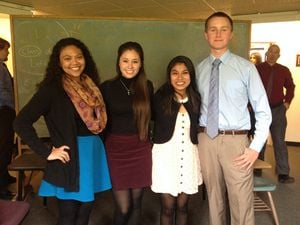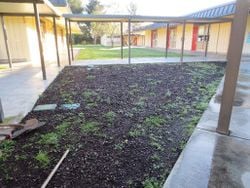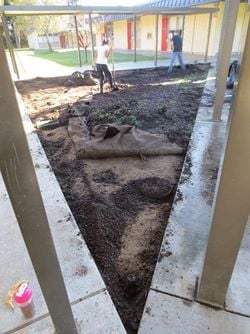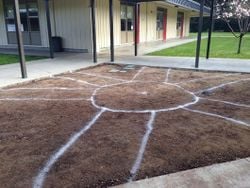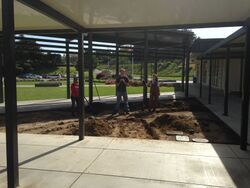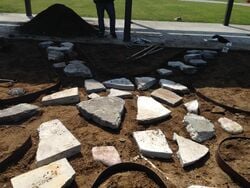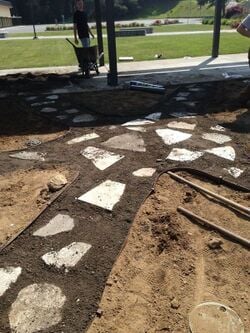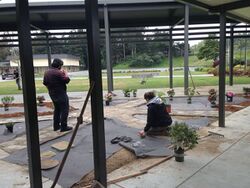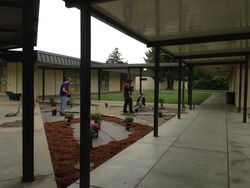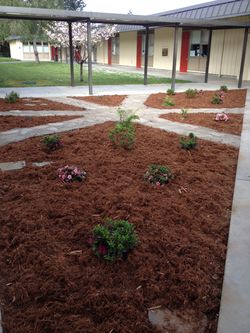m (→Abstract) |
|||
| Line 99: | Line 99: | ||
| | | | ||
|- | |- | ||
| | |Weed Mat | ||
|$60 | |$60 | ||
|Donated | |Donated | ||
Revision as of 17:42, 6 May 2015
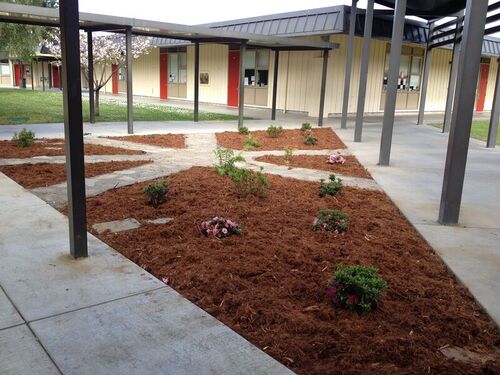
Abstract
The client is Zane Middle School, located in Eureka California. Zane Middle School is a “STEAM” (Science, Technology, Engineering, Art, Mathematics) school, and features sustainable projects such as a recycling program and a rainwater catchment system. For this project, Trevor Hammons and Ron Perry from Zane Middle School have requested that a patch of land nicknamed “the Triangle of Death” be converted into a hub of activity for the students.
Background
The Triangle of Life is designed as an alternative pathway that is aesthetically pleasing. This area provides seating, native plants, a pathway and aesthetically pleasing scenery presented in front of the school. Students will be provided a safe welcoming environment to socialize, eat lunch or cut through while headed to their destination. The triangle of life is presented in front of the school near the office and it will help guide visitors to the office and give provide a welcome when walking onto campus.
Problem statement and criteria
Criteria are standards that are based on a scaled system rather than a yes or no answer. Constraints are specific limitations on each of the criterion. These were determined by multiple meetings with the client and group brainstorming sessions. We followed these to create a final product we were proud of.
Criteria
| Criteria | Importance | Constraints |
|---|---|---|
| Functionality | 10 | Faculty, students, and visitors must be able to utilize the path without causing unnecessary foot traffic. |
| Low Maintenance | 10 | The maintenance staff needs to approve the final solution. The final design must not add any extra work for the maintenance staff. Therefore, the uses of native plants that thrive in the local climate and require little care are a priority. |
| Sustainability | 9 | Strive to use recycled materials that have low impact on the environment. |
| Aesthetics | 9 | The final solution must be unique and eye pleasing to the public because the design is a main focal point on the Zane Middle School’s campus. |
| Safety | 8 | No material utilized in the final design can be picked up and thrown by the students. Also, plants cannot be poisonous or have hardwood that can be broken and used as a weapon. Benches are restricted to one side of the triangle due to low hanging roofs on the other two sides. |
| Durability | 7 | The final design must withstand the destructive forces of middle school students. |
| Cost | 5 | The cost for all materials total below the $400 budget. The design must also be weighted with environmental impact in mind. |
Description of final project
The final design for the Triangle of life is shown below. There are six pathways that are laid out in the most logical fashion in order to avoid all obstacles such as utility boxes, sprinkler systems, and pillars. These pathways are made out of urbanite, and are packed together with a cement mix that is recycled out of the back of cement trucks. There is a circular area in the middle of the triangle to provide students with a social gathering area. This is also made from urbanite. Urbanite is implemented to reduce the amount of CO2 that enters the atmosphere because the production of new cement creates CO2 emissions. The open areas contain weed mat to prevent a rise in maintenance costs, evergreen plants to maintain an aesthetically pleasing landscape, and redwood mulch to match existing landscapes.
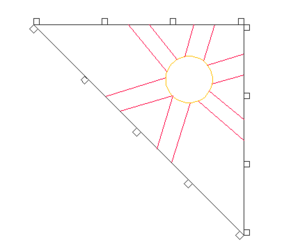
Costs
Maintenance
| Task | Cost (Hours/Month) |
|---|---|
| Weeding | 2.0 |
| Cutting back plants and clean area | 2.0 |
Design

Time (hours) costs invested in: problem formulation, problem analysis, alternative solutions, decision, and specification of solution.
Retail vs. Our Cost
| Material | Retail Cost ($) | Our Cost ($) | |
|---|---|---|---|
| Urbanite | $15 | Donated | |
| Recycled Sand | $300 | Donated | |
| Plants | $75 | Donated | |
| Gardening Material | $50 | $25 | |
| Edging | $120 | $60 | |
| Weed Mat | $60 | Donated | |
| Test Material | $100 | $30 | |
| Total Cost ($) | $720 | $115 |
Testing Results
Steps were too loose. Steps were too far apart. Flower beds were not level. These adjustments were made to produce the final product: add urbanite to secure stepping stones; add traction between stones; lay down weed tarp; finally, add plant-life.
How to build
References
See Help:Footnotes for more. Template:Reflist
Team Triangle of Life
